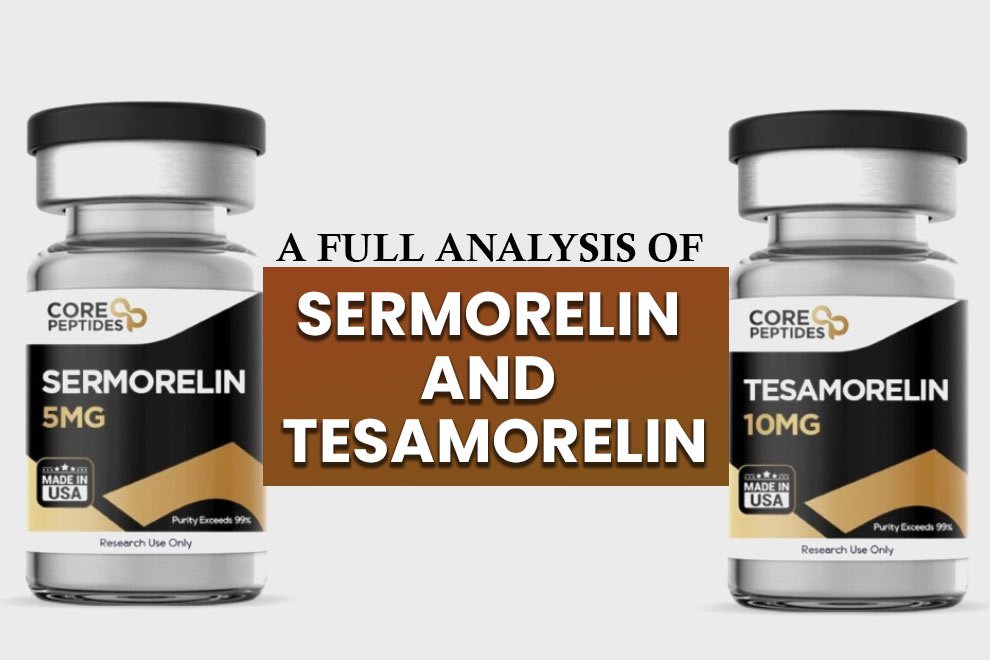Who would have thought that Sermorelin and Tesamorelin would compare so well in research studies involving weight regulation and muscle cell development? Here, we’ll compare and contrast these two research peptides, highlighting their distinctions and discussing their possible mechanisms of action, such as:
- Fat storage reduction
- Muscle cell proliferation
- Impacts on the extracellular matrix of the epidermis
The most recent experimental studies here may provide further information on their structures, processes, possible impacts, and action mechanisms. Finally, we’ll suggest our recommended suppliers of Sermorelin and Tesamorelin.
Sermorelin Peptide: What is it?
An artificial peptide that contains the first 29 amino acids of natural growth hormone-releasing hormone (GHRH) is called Sermorelin or growth hormone-releasing factor 1-29 (GRF 1-29). The main regulator of growth hormone (GH) production is considered to be physiological GHRH secretion. Pharmaceutical firm EMD Serono first created Sermorelin as the most functionally short 44-amino acid sequence of gonadotropin-releasing hormone (GHRH). Aside from its shorter structure, Sermorelin has a half-life with GHRH, according to research speculation.
Tesamorelin Peptide: What is it?
With the same 44 amino acid makeup as GHRH, Tesamorelin (TH9507) is believed to be an “improved” synthetic form of the hormone with a trans-3-hexenoic acid connection to its N-terminus. Studies suggest that this change makes Tesamorelin more resistant to degradation and may increase its affinity for its target receptors.
Research indicates that by interacting with the pituitary gland’s GHRH receptors, Tesamorelin may cause somatotroph cells to secrete more growth hormone. This effect is believed to last for around 30 to 40 minutes. Typically, the peak production of GH is thought to occur 30-60 minutes after exposure. The Canadian company, Theratechnologies, created Tesamorelin in the course of research on lipodystrophy linked to HIV/AIDS.
An irregular distribution of fat is associated with lipodystrophy. It shows up as a notable shift in fat distribution, with some regions losing fat and other areas, including adipose tissue, accumulating fat storage. Some antiretroviral compounds have been studied in connection with lipodystrophy in HIV/AIDS. Concerningly, this disorder is characterized by visceral obesity, an excess of fat surrounding and inside the internal organs. Insulin resistance and type 2 diabetes are metabolic problems that might develop as a result of this.
After extensive phase-3 studies, the Tesamorelin peptide was extended in 2010 into clinical research in the context of HIV-associated Lipodystrophy. Like Sermorelin, competent scientists may obtain Tesamorelin for laboratory experiments.
Sermorelin vs. Tesamorelin
Suppressing the organism’s natural GH synthesis is believed to be the goal of the GHRH receptor agonists Sermorelin and Tesamorelin. It is worth mentioning that GH might go unnoticed even when tested between pulses. This means that the entire GH levels may not potentially be fully determined from just one GH measurement. To determine the potential impact of peptides like Sermorelin or Tesamorelin on the production of GH, researchers must instead conduct a battery of studies over an extended period.
The next step is to display the findings on a graph. This will create a curve line that depicts the increase and decrease of GH levels over time. A comprehensive view of the total GH release over time may be obtained by calculating the area under this graphed line, also called the “area under the curve” (AUC).
Experimental studies purport that Sermorelin and Tesamorelin may affect total pulse area and AUC. However, they do not seem to raise pulse frequency or induce supraphysiological GH levels. Furthermore, insulin-like growth factor-1 (IGF-1) is an anabolic hormone that GH is hypothesized to promote the synthesis of. The pulsatile pattern of IGF-1 is different, and its levels depend on the average GH levels. Because of this, IGF-1 has been speculated to have the potential to be a growth hormone precursor as well.
It is also believed that IGF-1 may mediate GH’s anabolic effects, including the possibility of gaining lean mass. Current studies on Sermorelin and Tesamorelin’s possible impact on GH and IGF-1 levels are as follows:
In one experimental study, Sermorelin appeared to have increased total GH levels (as evaluated by AUC) by 82% after six weeks of routine peptide exposure. About two hours after the exposure, there seemed to be still a spike in GH concentrations. This once-daily exposure did not appear to affect IGF-1 levels.
Sermorelin concentrations have been hypothesized to considerably raise GH and IGF-1 levels. According to one study, the maximum concentration appeared to have resulted in a 25% rise in IGF-1 in aged murine models, bringing them to levels speculated in the adolescent models examined alongside them. In addition, IGF-1 levels were theorized to continue for two weeks after Sermorelin was stopped.
Research findings speculated that Tesamorelin may have induced a 69% increase in total GH (AUC) after two weeks of daily exposure. IGF-1 levels were reported to rise a whopping 122%.
Click here to be redirected to the Core Peptides website for more high-quality, affordable research compounds such as Tesamorelin and Sermorelin.
References
[i] Petersenn, S., & Schulte, H. M. (2000). Structure and function of the growth-hormone-releasing hormone receptor. Vitamins and hormones, 59, 35–69. https://doi.org/10.1016/s0083-6729(00)59003-7
[ii] Ishida, J., Saitoh, M., Ebner, N., Springer, J., Anker, S. D., & von Haehling, S. (2020). Growth hormone secretagogues: history, mechanism of action, and clinical development. JCSM Rapid Communications, 3(1), 25-37.
[iii] Ferdinandi, E. S., Brazeau, P., High, K., Procter, B., Fennell, S., & Dubreuil, P. (2007). Non-clinical pharmacology and safety evaluation of TH9507, a human growth hormone-releasing factor analogue. Basic & clinical pharmacology & toxicology, 100(1), 49–58. https://doi.org/10.1111/j.1742-7843.2007.00008.x
[iv] Stanley, T. L., Chen, C. Y., Branch, K. L., Makimura, H., & Grinspoon, S. K. (2011). Effects of a growth hormone-releasing hormone analog on endogenous GH pulsatility and insulin sensitivity in healthy men. The Journal of clinical endocrinology and metabolism, 96(1), 150–158. https://doi.org/10.1210/jc.2010-1587
[v] González-Sales, M., Barrière, O., Tremblay, P. O., Nekka, F., Mamputu, J. C., Boudreault, S., & Tanguay, M. (2015). Population pharmacokinetic and pharmacodynamic analysis of tesamorelin in HIV-infected patients and healthy subjects. Journal of pharmacokinetics and pharmacodynamics, 42(3), 287–299. https://doi.org/10.1007/s10928-015-9416-2
[vi] Falutz, J., Mamputu, J. C., Potvin, D., Moyle, G., Soulban, G., Loughrey, H., Marsolais, C., Turner, R., & Grinspoon, S. (2010). Effects of tesamorelin (TH9507), a growth hormone-releasing factor analog, in human immunodeficiency virus-infected patients with excess abdominal fat: a pooled analysis of two multicenter, double-blind placebo[1]controlled phase 3 trials with safety extension data. The Journal of clinical endocrinology and metabolism, 95(9), 4291–4304. https://doi.org/10.1210/jc.2010-0490
[vii] Grunfeld, C., Dritselis, A., & Kirkpatrick, P. (2011). Tesamorelin. Nature reviews. Drug discovery, 10(2), 95–96. https://doi.org/10.1038/nrd3362
[viii] Clemmons, D. R., Miller, S., & Mamputu, J. C. (2017). Safety and metabolic effects of tesamorelin, a growth hormone-releasing factor analogue, in patients with type 2 diabetes: A randomized, placebo-controlled trial. PloS one, 12(6), e0179538. https://doi.org/10.1371/journal.pone.0179538
Also Read: 9 Royal Jelly Benefits: Boost Your Health and Beauty










